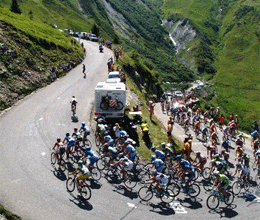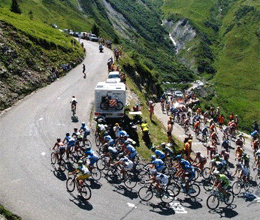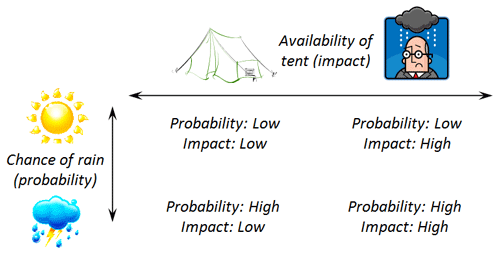
Managing Risk the Tour de France Way
 It’s the third mountain stage in the Tour de France (TdF). A few riders are in the lead as they wind their way up a mountain. The number of riders in the lead group starts dwindling – 12, 10, then 8. All of a sudden, around a hairpin bend, Jan Ullrich weaves across the road accelerating, pulling away from the pack. What will Lance Armstrong do? Chances are good that the US Postal team has thought about this risk and planned for it. This means that Armstrong will know exactly what to when Ullrich pulls this move, and the team has responded to many other risks up to this point to get Armstrong in the lead group.
It’s the third mountain stage in the Tour de France (TdF). A few riders are in the lead as they wind their way up a mountain. The number of riders in the lead group starts dwindling – 12, 10, then 8. All of a sudden, around a hairpin bend, Jan Ullrich weaves across the road accelerating, pulling away from the pack. What will Lance Armstrong do? Chances are good that the US Postal team has thought about this risk and planned for it. This means that Armstrong will know exactly what to when Ullrich pulls this move, and the team has responded to many other risks up to this point to get Armstrong in the lead group.
Before I “race” into what Armstrong does and how the TdF teams manage risk, I figure that I should discuss risk analysis. Risk Analysis is technique 9.24 in the BABOK v2.0 that you should become familiar with. If you’re not familiar with risk analysis, this is the article for you.
A risk is an uncertain event or occurrence that can have a negative or positive effect on the project team’s ability to achieve an objective.
How do you plan for uncertain events? Through creation of a risk management plan!
The risk management plan includes a list of the possible risks that you may face during the project. You should create this at the beginning of the project, and update it as the project progresses. Each risk should include a description of the risk, the likelihood that a particular risk will occur and its impact, and how the team is going to respond to the risk should the risk become reality. Now because risks are really uncertain events, and uncertainty is just, well, uncertain, you can’t possibly plan for every risk so concentrate on those that are more likely. For instance, if one of your stakeholders suggests that you hold your requirements workshops in the building’s new outdoor garden courtyard, a reasonable risk would be that it might rain forcing cancelation of the workshop; while pieces of Skylab falling out of the sky would not.
Another thing that you need to include in the plan is your team’s Risk Tolerance. This is how much risk can be tolerated, and it may be different at different points in the project. Tolerance levels are: Risk Averse – will seek to reduce negative risks and accepts reduction in potential benefits in return for a more certain outcome; Risk Neutral – the benefit of the risk response must outweigh the “costs”; and Risk Seeking – willing to accept high risks in order to maximize chances of success.
Let’s look at the relationship between probability and impact. Suppose that we come up with a risk that it might rain on the day of our requirements workshop. The probability would be the chance that it would rain. The impact could be high or low depending on the availability of a tent or shelter. Our response could be different depending on how we plan to respond. For instance, we might avoid (hire a company to erect tents in the courtyard), accept (oh, well, we’ll just get wet), or mitigate (negotiate with the stakeholder to host the meeting in the company boardroom instead to lessen the chance of the impact). How do you determine probability? Look at the weather report, or if it’s too far into the future, look at the region. If you’re in Seattle, rain probability is High – Arizona? Low.
At this point, you have a list of events that may occur such as the table below.

| Risk | Probability | Impact | Trigger | Response |
| It may rain during the outdoor workshop | High | Low | Begins raining | Avoid – we will erect tents in the courtyard garden large enough to house all meeting participants |
So how does all this risk management work in the Tour de France?
The TdF is a grueling 2,000 mile + stage race, with twenty teams and 10 riders per team. It takes place over three weeks in July, and the winner is the one with the lowest overall time across multiple individual day races (called stages). Very simple objective – tough to get there.
Each team has examined its own strengths and weaknesses, so they have their own way of approaching the risks that present themselves in the race (you have performed a SWOT analysis, haven’t you?). Let’s look at one team’s stage one risk management plan. No one has started racing yet, so there is no leader. It’s a flat stage so there will be a mass sprint at the end. Your team does not have a great sprinter (your team’s weakness), so you probably are going to consider yourself risk-averse at this point. You don’t want your riders to risk getting caught up in a big crash at the end, ruining those cyclists on your team that are really good in the mountain stages (your strength). So, let’s create a risk. The risk is that your team will likely not win this stage. The probability that this will happen is high because you don’t have a strong sprinter. The impact is low because in this stage, riders will only be seconds apart instead of minutes or hours, and that time will be easily gained in the mountain stages. Your strategy is then to accept the risk. There is no real effort to try and win this stage because you are going to win in the mountains with your climbers.
So, now we’re into week two of the TdF and in the mountains. Armstrong is in first place overall, but there are some challengers who are within striking distance and could challenge him for the yellow jersey (what the overall leader wears in the race). Lance also put in a very fast climb yesterday so he has a two-minute advantage over second place. Will we be risk averse or seek risks in today’s race? Generally, the strategy would probably be neutral – protect the yellow jersey and only attack if the opportunity presented itself. Let’s list some of the risks that may be on this day’s risk management plan.
| Risk | Probability | Impact | Trigger | Response |
| Jan Ullrich attacks | High | High | Ullrich accelerates on a climb | Mitigate – Armstrong will hang on Ullrich’s wheel, making Ullrich do the work but will not let Ullrich gain time. |
| Stephane Heulot attacks on the mountain stage | High | Low | Heulot accelerates or breaks away on a climb | Accept – Heulot is 45 minutes behind Armstrong in overall time and will not be able to gain that much time on the climb. Armstrong will not win the stage, but will not lose the overall classification. Armstrong will let Heulot get away. |
| Richard Virenque attacks | High | Medium | Virenque attacks on a climb | Exploit – Virenque is an excellent climber, and if Armstrong can force Virenque into the attacking position, Armstrong can ride on his wheel, making him do more of the work while Armstrong still retains the lead in the overall classification. |
These are just some of the risks that the race team managers and the riders face every day. They plan for some of these uncertain events and react based on the response that they have planned out. How can you use the lessons from the TdF on your projects?
Follow these three steps:
- Think about what uncertain events might arise within your project. Write them down. These are your risks. For instance, one stakeholder would like to hold the requirements workshops in the company’s new garden courtyard. A risk may be that it might rain during those sessions.
- For each one of those uncertain events (risks), determine what the likelihood is that each one will materialize and then the impact of that. In Seattle, WA, raining on outdoor events is a higher priority than it is in Phoenix, AZ.
- Determine what will trigger the realization of the risk (how you know that it’s happening), and how you will respond when it occurs. This is your risk response. For instance, if the rain starts, that will trigger your risk response. You then know exactly how your team is going to respond because you have thought it out ahead of time.
Remember, BAs should perform risk analysis because not everything will go as planned. By developing appropriate responses, you are effectively planning for some of those situations that may not go as you expected. You will be able to keep the project moving in order to accomplish your objectives and not stumble or stall because the team doesn’t know what to do.
So what did Armstrong do when Ullrich attacked? Armstrong accelerated right along with him. He knew the risk that Ullrich posed, but instead of thinking about his response, it was calculated and thought out that morning with the team director. But don’t worry about Armstrong coming into your company and taking over your job as a BA just yet – he’s training for this year’s TdF showdown with Alberto Contador.
Don’t forget to leave your comments below
Paul Mulvey, CBAP, is a Lead Business Systems Analyst at UPS. He currently rides a Merlin road bike and runs a 53/39 up front and an 11-21 in the back, although with that ratio, the climbs seem to get harder each year. He can be reached at [email protected].